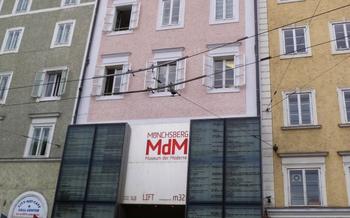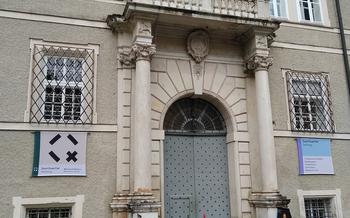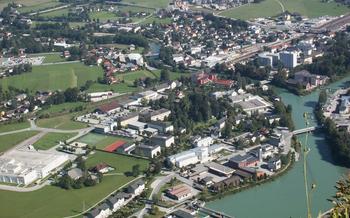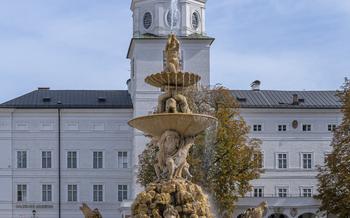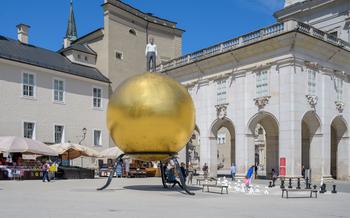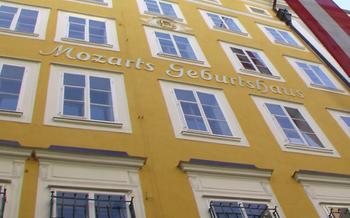
Salzburg Cathedral
- Salzburg Cathedral: A Majestic Symbol of Baroque Splendor
- Awe-Inspiring Dome: A Masterpiece of Baroque Engineering
- Sacrament Chapel: A Hidden Gem of Artistic Grandeur
- Statues of the Apostles: Silent Witnesses of Faith
- Organ Masterpieces: Instruments of Divine Harmony
- Crypt and Catacombs: A Journey into Salzburg's Past
- Residenzplatz: A Square of Architectural Wonders
- Mozart's Birthplace: A Homage to a Musical Genius
- Hohensalzburg Fortress: A Majestic Guardian of the City
- Getreidegasse: A Vibrant Shopping Street
- Kapuzinerberg and Kapuzinerkloster: A Peaceful Oasis
- Insider Tip: Exploring Salzburg's Hidden Gems
Salzburg Cathedral: A Majestic Symbol of Baroque Splendor
Salzburg Cathedral, with its imposing façade and majestic dome, stands as a grand testament to the Baroque architectural style. Step inside to discover an awe-inspiring interior adorned with intricate carvings, stunning frescoes, and magnificent marble altars. The cathedral's rich history unfolds through its very walls, from its founding by Saint Virgil in the 8th century to its role as a spiritual and cultural center during the reign of the prince-archbishops. Guided tours offer an immersive experience, delving into the cathedral's captivating stories and showcasing its hidden treasures.
Awe-Inspiring Dome: A Masterpiece of Baroque Engineering
The Salzburg Cathedral's dome stands as a testament to the architectural prowess of the Baroque era. Its sheer size, measuring an impressive 71 meters in height, is a testament to the ambition and skill of its builders. The dome's intricate design, featuring a series of interlocking ribs and pendentives, showcases the innovative construction techniques employed during its construction.
Inside the dome, visitors are greeted by a breathtaking array of frescoes and murals that adorn the walls and ceiling. These exquisite works of art depict biblical scenes and celestial wonders, creating a sense of awe and wonder. The dome's design is not merely an aesthetic marvel but also carries symbolic significance. It represents the connection between heaven and earth, inviting the faithful to contemplate the divine realm.
To fully appreciate the grandeur of the dome, visitors can ascend to the viewing platforms located at the base of the dome. These platforms offer panoramic views of the city, allowing visitors to admire the cathedral's imposing presence amidst the cityscape. The breathtaking vista from the viewing platforms makes for an unforgettable experience, providing a unique perspective on Salzburg's architectural beauty.
Sacrament Chapel: A Hidden Gem of Artistic Grandeur
Nestled within the majestic Salzburg Cathedral, the Sacrament Chapel stands as a testament to the exquisite artistry and devotion that permeated the Baroque era. Step inside this sacred space, and your gaze will be captivated by the stunning altarpiece, a masterpiece crafted from precious materials and adorned with intricate carvings and delicate paintings. The life-size figures of the twelve apostles, rendered in gleaming marble, seem to stand guard over this sacred sanctuary, their expressions conveying a sense of awe and reverence.
Explore further, and you'll discover a wealth of Baroque details that adorn every corner of the chapel. Intricate stucco work, gilded ornaments, and vibrant frescoes create a symphony of artistic expression, harmoniously blending to evoke a sense of celestial grandeur. The chapel's atmosphere is one of tranquility and devotion, inviting visitors to pause and reflect upon the sacred mysteries that unfold within its walls.
Visiting the Sacrament Chapel is an experience not to be missed. Its doors are open to all who seek solace, inspiration, or simply an appreciation for the beauty and artistry of the Baroque era. Practical information, such as visiting hours, ticket prices, and accessibility, can be easily obtained from the cathedral's website or through a local tourist information center.
Statues of the Apostles: Silent Witnesses of Faith
The twelve apostles, revered figures in Christianity, hold a prominent place within Salzburg Cathedral. These life-size statues, crafted with exquisite detail, stand as silent witnesses to the faith and devotion that permeate this sacred space. Each apostle is depicted with unique attributes and characteristics, reflecting their individual personalities and roles within the Christian narrative.
Saint Peter, the rock upon which the church was built, stands with his keys, symbolizing his authority. Saint Paul, the apostle to the Gentiles, carries a sword, representing his zeal for spreading the gospel. Saint John, the beloved disciple, is often shown with a chalice, symbolizing the Last Supper and his closeness to Jesus.
The apostles are strategically positioned within the cathedral, flanking the main altar and occupying niches along the nave. Their presence reminds visitors of the foundation of the church and the enduring legacy of the apostles' teachings. These statues serve as a tangible connection to the early days of Christianity, evoking a sense of awe and reverence among believers.
To fully appreciate the artistry and symbolism of the statues, visitors can embark on a self-guided tour or join a guided tour led by knowledgeable docents. These tours provide insights into the history, symbolism, and artistic techniques behind the sculptures, enhancing the visitor's understanding of their significance within the cathedral.
Whether admiring them from a distance or up close, the statues of the apostles leave a lasting impression on visitors to Salzburg Cathedral, reminding them of the enduring power of faith and the legacy of those who dedicated their lives to spreading the message of Christianity.
Organ Masterpieces: Instruments of Divine Harmony
The Salzburg Cathedral is home to two magnificent organs, each with its own unique history and characteristics. The larger of the two, the Grand Organ, was built in the 17th century and boasts over 4,000 pipes. Its rich and powerful sound fills the cathedral during Mass and concerts, creating an atmosphere of awe and inspiration. The smaller organ, the Mozart Organ, was built in the 18th century and is renowned for its delicate and expressive tone. It is often used for solo recitals and chamber music performances.
In addition to their musical significance, the organs are also works of art in their own right. The Grand Organ is adorned with intricate carvings and sculptures, while the Mozart Organ features a beautifully painted case. Both organs are carefully maintained and regularly restored to ensure that they continue to delight visitors for generations to come.
If you are fortunate enough to attend a concert or Mass at the Salzburg Cathedral, be sure to take some time to admire these magnificent instruments. Their beauty and sound will leave you breathless.
Practical Tips:
- Organ concerts are held regularly at the Salzburg Cathedral. Check the cathedral's website for the concert schedule and ticket prices.
- Guided tours of the cathedral often include a visit to the organ loft, where you can see the organs up close and learn more about their history and construction.
- If you are interested in learning more about the organs, there are several books and articles available on the subject. The cathedral gift shop also sells a variety of souvenirs related to the organs.
Crypt and Catacombs: A Journey into Salzburg's Past
Beneath the grandeur of Salzburg Cathedral lies a hidden world of history and intrigue—the crypt and catacombs. These subterranean chambers served as the final resting place for Salzburg's archbishops and other prominent figures, offering a glimpse into the city's rich past.
The crypt, with its vaulted ceilings and intricate carvings, exudes an atmosphere of solemnity and reverence. Here, visitors can pay their respects to the former leaders of the archdiocese, whose elaborate tombs and epitaphs recount their lives and accomplishments. Among the most notable burials is that of Archbishop Wolf Dietrich von Raitenau, a controversial figure who left an indelible mark on Salzburg's history.
Descending further into the depths of the cathedral, visitors enter the catacombs, a labyrinth of narrow passages lined with niches that once held the remains of Salzburg's elite. The air is cool and damp, and the walls are adorned with macabre artwork depicting skeletons and skulls, a reminder of the transience of life.
Guided tours of the crypt and catacombs provide a fascinating insight into Salzburg's history and funerary traditions. Visitors can learn about the lives and deaths of the archbishops, the significance of their burials, and the symbolism of the artwork that adorns their tombs. The tours are available in several languages and offer a unique opportunity to explore a hidden aspect of Salzburg's rich heritage.
Whether you're a history buff, an architecture enthusiast, or simply curious about what lies beneath the surface of Salzburg Cathedral, the crypt and catacombs are a must-visit destination. Prepare to be transported back in time as you delve into the depths of this subterranean world and discover the secrets of Salzburg's past.
Residenzplatz: A Square of Architectural Wonders
Residenzplatz, the heart of Salzburg's Old Town, is a stunning ensemble of architectural masterpieces that seamlessly blend various styles, creating a harmonious and awe-inspiring urban space. Dominated by the magnificent Salzburg Cathedral, the square exudes an aura of grandeur and elegance.
To the east of the cathedral stands the imposing Salzburg Residenz, the former palace of the prince-archbishops. With its Baroque facade, intricate carvings, and opulent state rooms, the Residenz now serves as a museum, offering a glimpse into the lavish lifestyle of Salzburg's former rulers.
Across the square, the Mirabell Palace and its stunning gardens provide a serene contrast to the grandeur of the cathedral and the Residenz. Built as a summer residence for the prince-archbishops, the palace is a masterpiece of Baroque architecture, surrounded by beautifully landscaped gardens adorned with fountains, sculptures, and colorful flowerbeds.
Visitors to Residenzplatz can stroll through the square, admiring the architectural wonders that surround them. Take a moment to relax in one of the cafes or restaurants that line the square, soaking up the vibrant atmosphere and enjoying the stunning views.
Mozart's Birthplace: A Homage to a Musical Genius
In the heart of Salzburg, nestled amidst charming streets and historical buildings, lies the birthplace of one of the world's most celebrated composers, Wolfgang Amadeus Mozart. This significant site, now transformed into a museum, offers visitors a fascinating glimpse into the life and legacy of a musical prodigy.
The birthplace, located at Getreidegasse 9, is a three-story building that once housed the Mozart family. Step inside, and you'll be transported back in time to the 18th century, where Mozart spent his early years surrounded by music and creativity. Explore the charming rooms, each filled with artifacts, portraits, and personal belongings that tell the story of Mozart's childhood and his remarkable talent.
The museum's exhibits showcase Mozart's musical genius from his earliest compositions to his later masterpieces. Admire his original manuscripts, including the score for his opera "The Magic Flute," and learn about his influences and inspirations. Interactive displays allow visitors to engage with Mozart's music, listen to his compositions, and even try their hand at playing a replica of his childhood violin.
For a truly immersive experience, join a guided tour led by knowledgeable experts who will share captivating anecdotes and insights into Mozart's life and work. Discover the challenges he faced, his relationships with his family and fellow musicians, and the impact he had on the world of classical music.
Visiting Mozart's birthplace is a must for any music lover or anyone interested in Salzburg's rich cultural heritage. It's a chance to pay homage to a musical genius and gain a deeper appreciation for his extraordinary contributions to the world of music.
Hohensalzburg Fortress: A Majestic Guardian of the City
Standing proudly atop Festungsberg, Hohensalzburg Fortress reigns as a symbol of Salzburg's rich history and architectural prowess. Its imposing presence, visible from almost every corner of the city, invites visitors to delve into a world of medieval grandeur and captivating tales.
Built in the 11th century, the fortress initially served as a defensive stronghold, protecting the city from potential invaders. Over the centuries, it underwent numerous expansions and renovations, evolving into a formidable military complex that housed soldiers, cannons, and other defensive mechanisms.
In the 16th century, the fortress underwent a significant transformation under the rule of Prince-Archbishop Leonhard von Keutschach. He commissioned the construction of new fortifications, towers, and courtyards, enhancing the fortress's defensive capabilities while also adding a touch of Renaissance elegance.
Today, Hohensalzburg Fortress stands as a living testament to Salzburg's rich past. Visitors can explore its many attractions, including the Salzburg Museum, the Marionette Museum, and the Golden Hall, each offering a glimpse into different aspects of the fortress's history and cultural significance.
From exploring its ancient dungeons to walking along its mighty walls, Hohensalzburg Fortress offers a captivating journey through time, providing visitors with a unique perspective on Salzburg's fascinating past.
Getreidegasse: A Vibrant Shopping Street
Stroll along Getreidegasse, Salzburg's most famous shopping street, and immerse yourself in its unique charm. This narrow cobblestone street, lined with preserved medieval buildings, exudes a timeless atmosphere. Getreidegasse is a shopper's paradise, offering a delightful mix of traditional boutiques, international brands, and souvenir shops. Browse through exquisite handcrafted goods, local delicacies, and unique souvenirs that capture the essence of Salzburg. Don't miss the Getreidegasse Arch, a stunning gateway that marks the entrance to the street. And while you're here, be sure to visit the birthplace of Wolfgang Amadeus Mozart, one of Salzburg's most famous sons. Getreidegasse is also home to a variety of charming cafes and restaurants, offering a perfect respite from your shopping adventures. Take a break and savor a traditional Austrian pastry or indulge in a delicious meal while soaking in the vibrant atmosphere of this historic street.
Kapuzinerberg and Kapuzinerkloster: A Peaceful Oasis
Nestled on a hill overlooking the city of Salzburg, Kapuzinerberg offers a tranquil escape from the bustling streets below. The Kapuzinerkloster, a Capuchin monastery founded in 1599, is a place of peace and reflection, with stunning views of the city and the surrounding mountains. Visitors can explore the monastery's beautiful gardens, wander through the serene Kapuzinerberg woods, or simply relax and enjoy the tranquility of this hidden gem.
The Kapuzinerberg woods are a natural paradise, with a network of walking trails that wind through dense forests, past babbling brooks, and over lush meadows. Keep an eye out for the local wildlife, which includes deer, squirrels, and a variety of bird species. For those seeking a more spiritual experience, the monastery offers guided tours that provide insights into the history and significance of this sacred place.
To reach Kapuzinerberg, you can either take a leisurely walk from the city center or hop on the Kapuzinerbergbahn, a funicular that offers stunning views during the ascent. Once you reach the top, take some time to explore the monastery and its gardens, soak in the breathtaking views, and enjoy the serenity of this peaceful oasis.
Insider Tip: Exploring Salzburg's Hidden Gems
Beyond the popular tourist attractions, Salzburg offers a treasure trove of hidden gems waiting to be discovered. One such delight is the Mirabell Secret Garden, a secluded oasis nestled within the Mirabell Palace grounds. With its manicured lawns, colorful flower beds, and tranquil atmosphere, this hidden garden offers a serene escape from the city's hustle and bustle.
For a glimpse into Salzburg's authentic side, venture into charming neighborhoods like Nonntal or Aigen. These picturesque areas showcase traditional architecture, cozy cafes, and local shops, providing a glimpse into the city's daily life. Don't miss the opportunity to indulge in Salzburg's culinary delights at local markets or cozy restaurants. Sample traditional dishes like Salzburger Nockerl, a fluffy soufflé-like dessert, or Kasnocken, a hearty dish of cheese spaetzle.
If you're looking for a unique museum experience, explore off-the-beaten-path options like the Toy Museum, showcasing a fascinating collection of toys from different eras, or the Museum of Natural History, housing exhibits on the region's flora and fauna. These hidden gems offer a fresh perspective on Salzburg's rich history and culture.
